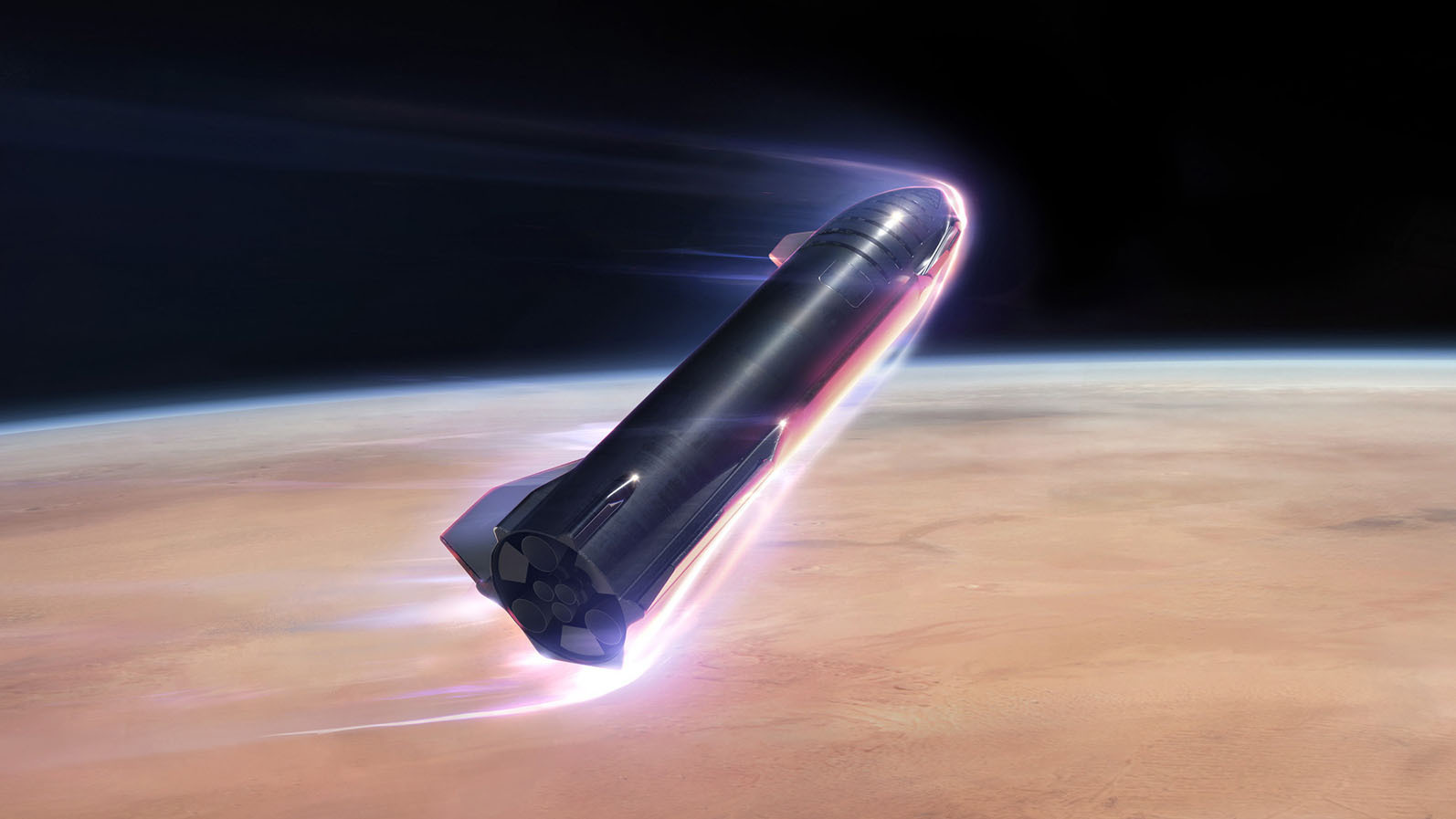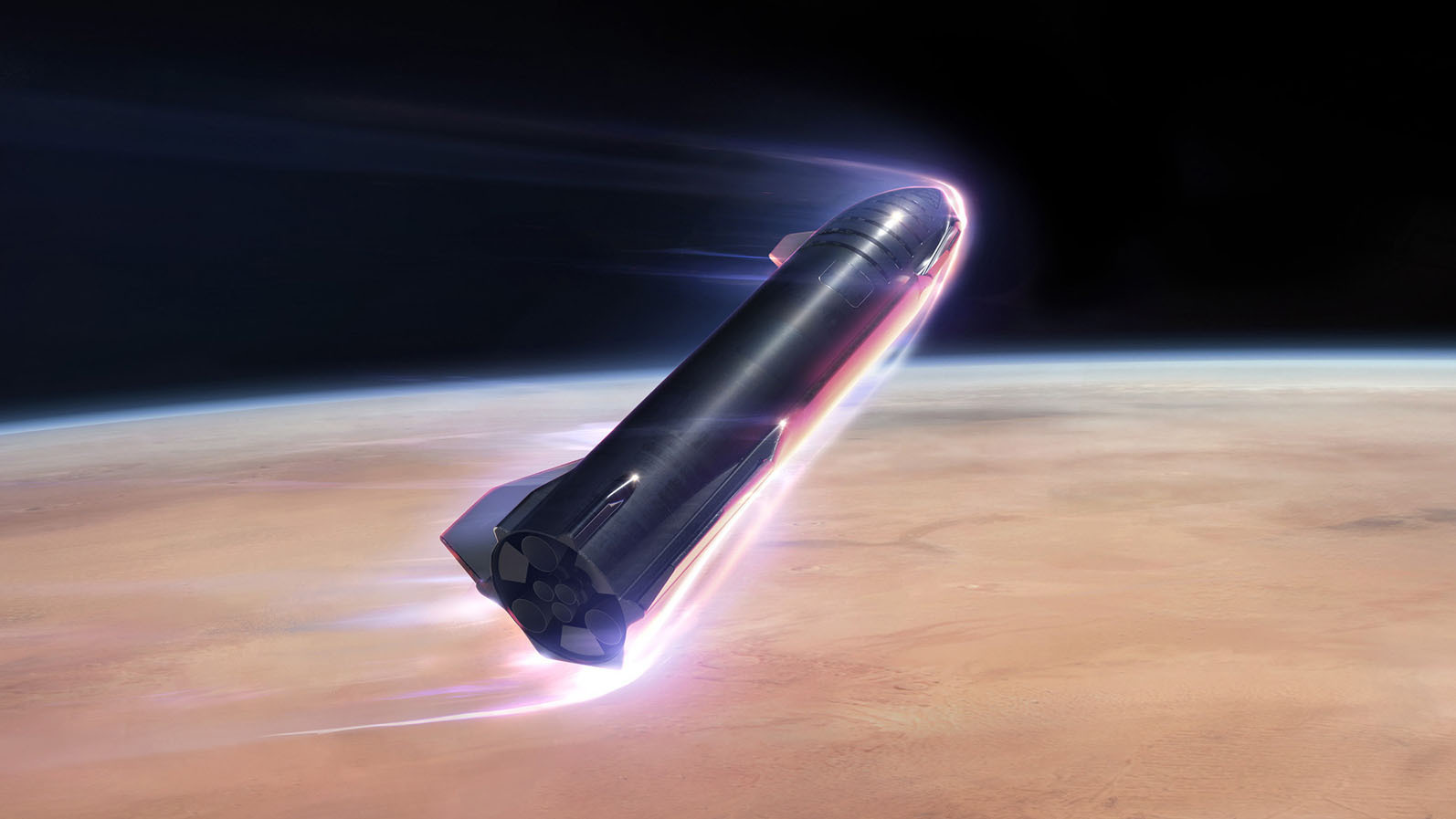
How SpaceX’s Starship Will Re-Enter The Atmosphere
SpaceX’s Starship is a unique spacecraft that will change the future of the space industry if successful. However, it first has to accomplish many different challenges. One of the most dangerous and complex is entering Earth’s atmosphere. With temperatures reaching over 3000 degrees it is no easy task. Considering Starship’s first orbital test flight is just around the corner, it is likely we will see its first attempt very soon.
To re-enter the atmosphere Starship will begin at a 60-degree angle in a belly-flop position. Additionally, more than 50% of it will be covered in hexagonal heat shield tiles. The heat shielding plus Starship’s stainless steel construction will ensure it can survive the 3000+ degrees it will be exposed to during re-entry.
Starship’s re-entry will have some similarities to the Space Shuttle. Mainly the angle as it enters the atmosphere and the placement of the heat shield. The big difference being the Space Shuttle used a very complex heat shield system with hundreds of unique pieces. This system however ended up making the Space Shuttle cost more, take longer to reuse, and compromised its safety. Starship is planning on having the majority of tiles be the exact same. This will help cut down on cost and speed up production.
Angle Of Entry
When Starship first starts to re-enter the atmosphere it will be positioned right around a 60-degree angle. This has to do with the design of Starship and its goals for landing. Without getting too complex the attack angle allows Starship to have more control thanks to its forward and aft flaps. Also, this angle of entry will help position Starship for its full horizontal belly-flop once it has slowed down significantly. To be more specific after Starship has slowed down and is through the majority of the atmosphere it will belly-flop straight down. Using its wide-body and flaps Starship will then position itself and do an engine burn prior to landing. The engines will light and flip the rocket from a horizontal position to a vertical one. You can see an example of this on SpaceX’s SN15 test flight below.
Starship Heat Shield

Starship’s heat shield construction consists of a large array of hundreds of hexagonal thermal protection tiles. They cover over 50% of Starship to help withstand the high temperatures of re-entering the atmosphere. Starship not only has tiles along the main half and flaps but also certain areas on the side as well. SpaceX has added additional tiles to the side of the flaps because they expect a lot of heat to be redirected to those areas also.
The majority of tiles are exactly the same except for a few specific areas. One of those areas includes the flaps. Both at the top and bottom, the flaps require special dimensions for some of the tiles near the joints and aero covers. The other place is near the top where Starship has some mounting points. This however is very likely to change in the future Starship models and will only require regular tiles to cover the nose.
The reason SpaceX is using this simple and almost completely uniform design is for cost and speed. Starship is meant to not only be reusable but quickly reusable. After Starship re-enters the atmosphere SpaceX will need to check the tiles and ensure they are ready for another launch. If not they would be able to quickly swap out any compromised tiles because of their simple and consistent design.
Stainless Steel Construction
Another unique aspect of Starship is the material it’s constructed out of. Currently, the Starship models are using 304L stainless steel. Unlike a lot of other rocket companies and agencies that use more complex and light materials. The benefit to the material SpaceX is using includes cost, production, and heat resistance.
One of the major benefits is cost. SpaceX wants to produce hundreds of Starships and have an average launch cost of only $2 million. The material SpaceX is using is a big factor in that number. Other companies often use very expensive materials and composites that include carbon fiber and a lot of machining. The stainless steel meant for Starship is very affordable in comparison. Additionally, the production is a lot simpler and helps reduce the time spent constructing Starship.
One last benefit of using stainless steel is heat resistance. This has a direct effect on how Starship will re-enter different atmospheres such as Earth’s. Compared to other materials like carbon fiber stainless steel has a very high melting point. This high melting point allows SpaceX to use a thinner less invasive heat shield. Together they will be capable of withstanding re-entering Earth’s atmosphere.
Will It Work For Other Planet’s Atmospheres?
Mars’s atmosphere is 95% carbon dioxide and around 1% oxygen. It is also much thinner than Earth’s at around 1%. This planet brings up multiple challenges one being the rocket will still experience a massive amount of heat while entering the atmosphere. Specifically, the surface material when entering approaches 4000 degrees farenheit. This means that yes Starship will be capable of entering the atmosphere but it will still be quite the challenge.
The other downside includes Mars’s thin atmosphere. The atmosphere is so thin it will not slow down objects nearly as much as Earth. This means Starship will have to do more work on its landing burn prior to touch down. Below is an engineering simulation of Starship landing on Mars provided by SpaceX.
Space Shuttle Comparison
SpaceX’s Starship does share some similarities with the Space Shuttle. The main one being heat shield placement and how they re-enter the atmosphere. Both Starship and the Space Shuttle have a fully reusable upper stage. This is the reason they both re-entered the atmosphere rather than being left in space or burnt up. More specifically both first stages use a belly-flop method for entry and have the majority of one side covered in heat shielding.
However, there are some differences as SpaceX has learned from the Space Shuttle’s mistakes. An example of this would be using the same type of tiles. The Space Shuttle had massive delays and cost hundreds of millions of dollars per launch for multiple reasons including heat shielding. The Space Shuttle had hundreds of different heat shield sections each completely unique. This meant that after every launch a large crew would have to inspect and replace the exact version. To avoid this expensive and slow mistake SpaceX is using almost entirely uniform tiles. This will help cut down on costs and speed up the reusability of the rocket.
Conclusion
Starship is a completely new and innovative spacecraft that is likely to change the space industry. Before it can do that it needs to complete one of the more complex challenges in spaceflight and safely re-enter the atmosphere in one piece. Starship uses a large array of uniform hexagonal tiles along with stainless steel construction to withstand the heat. These factors will help keep Starship together and slow it down significantly before landing. If SpaceX is successful with this design they will have a reliable and cost-effective solution that will make them one step closer to putting the first humans on Mars.
